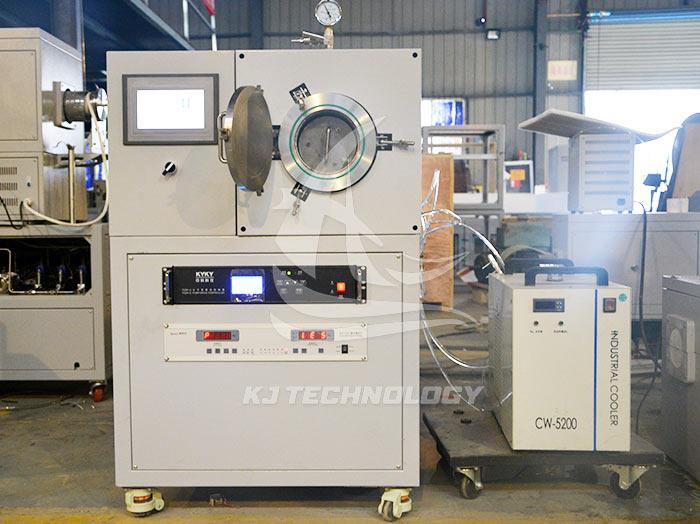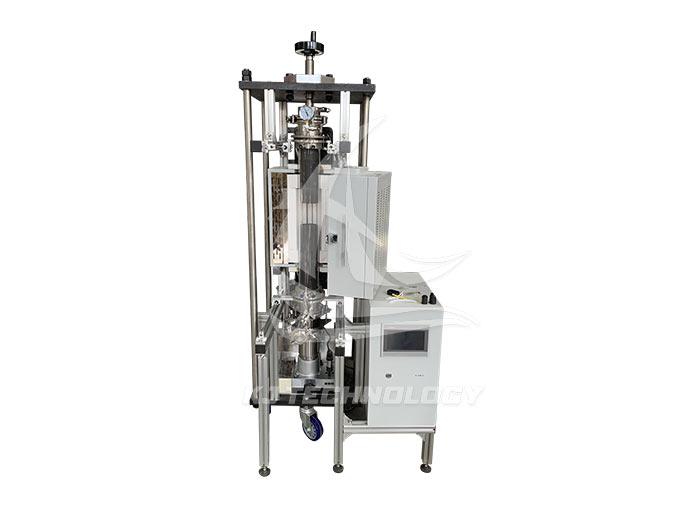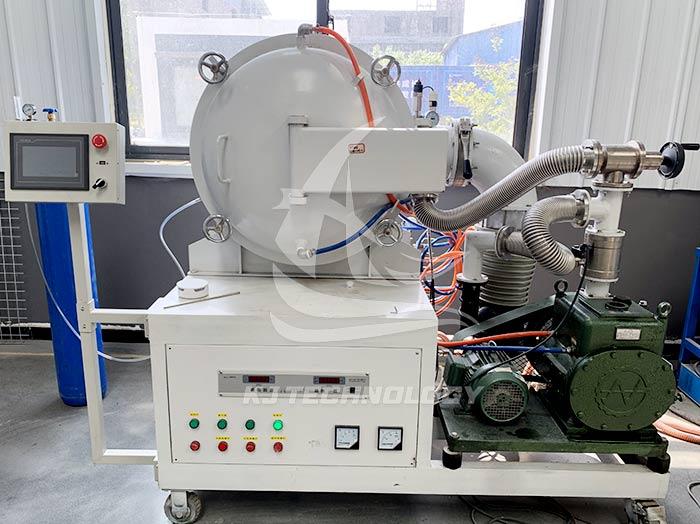Precautions for using a vertical graphite vacuum furnace
 09-03-2025 Author: KJ technology
09-03-2025 Author: KJ technology
As a precision equipment in high-temperature and vacuum environments, the use of vertical graphite vacuum furnaces requires strict adherence to operating standards to ensure safety, prolong equipment life, and improve process quality. The following is a detailed summary of key precautions:
1. Preparation before operation: Ensure equipment and environmental safety
environment check
Cleanliness: There are no flammable or explosive materials, corrosive gases, or dust within 5 meters around the furnace body to prevent fires or equipment corrosion caused by high temperatures.
Ventilation conditions: Ensure that the exhaust system is functioning properly and prevent the accumulation of volatile gases (such as hydrogen) at high temperatures, which could pose a risk of explosion.
Power stability: Check if the voltage fluctuation of the three-phase power supply is within ± 5% to avoid damaging the heating element or control system due to unstable voltage.
Equipment inspection
Vacuum system: Check the oil level of the vacuum pump (at 1/2~2/3 of the oil window), oil quality (without emulsification or discoloration), and test the accuracy of the vacuum gauge (calibrated with a standard vacuum gauge).
Cooling system: Confirm that the cooling water flow rate is ≥ 40 L/min, the water temperature is ≤ 35 ℃, there is no water leakage, and avoid deformation of the furnace body or burning of heating elements at high temperatures.
Gas pipeline: Check whether the needle valves at the inlet and outlet are flexible, whether the gas purity meets the process requirements, and prevent impurities from contaminating the materials.
Material preparation
Cleanliness: The surface of the material should be free of oil stains, metal shavings, or moisture to avoid volatilization and contamination of the furnace chamber or damage to the vacuum pump at high temperatures.
Size matching: The material size should be less than 80% of the effective volume of the furnace chamber to avoid a decrease in temperature uniformity caused by over dense loading.
Graphite crucible inspection: Confirm that the crucible has no cracks, oxide layers, or impurities attached to prevent cracking or material contamination at high temperatures.
2. Standard operation: strictly follow the process flow
Vacuum pumping stage
Gradual pumping: First, evacuate to a low vacuum of 10 ⁻¹ Pa, then switch to a high vacuum pump to pump to the required vacuum degree (such as 10 ⁻³ Pa) to avoid instantaneous expansion of impurity gases and damage to the vacuum pump.
Leakage detection: After vacuuming, maintain pressure for 10 minutes and observe the change in vacuum degree (≤ 5 Pa/min is qualified). If there is a leak, check the furnace door sealing ring, flange connection or observation window.
heating phase
Heating rate control: Set the heating curve according to the material characteristics (such as graphite treatment requiring ≤ 10 ℃/min) to avoid material cracking or furnace deformation caused by thermal stress.
Temperature uniformity monitoring: Real time monitoring of temperature difference inside the furnace through multi-point thermocouples (required to be ≤± 5 ℃ @ 2600 ℃). If the temperature difference exceeds the limit, the heating power or furnace airflow needs to be adjusted.
Atmosphere dynamic adjustment: In CVD deposition or reduction reactions, the gas flow rate needs to be adjusted in real time according to process requirements (such as H ₂ flow rate needs to be linked with temperature control) to ensure reaction stability.
cooling stage
Natural cooling priority: Forced ventilation cooling is prohibited at high temperatures (>800 ℃) to avoid thermal shock cracking of the furnace body. The furnace door should be opened only when the temperature drops below 200 ℃.
Continued atmosphere protection: If material activity needs to be maintained (such as negative electrode materials for lithium-ion batteries), argon gas should be continuously introduced to room temperature during the cooling process to prevent oxidation.
3. Safety protection: prevent high temperature, vacuum, and electrical risks
personal protection
High temperature protection: Operators should wear insulated gloves, protective face shields, and heat-resistant shoes to avoid contact with the surface of the furnace (>60 ℃) or splashing high-temperature materials.
Vacuum protection: When vacuuming or breaking the vacuum, it is necessary to stay away from observation windows and furnace doors to prevent glass breakage or material splashing from injuring people.
Gas protection: When introducing toxic gases (such as Cl ₂), it is necessary to operate in a fume hood and equip it with a gas leak alarm device.
Equipment safety
Overload protection: Ensure that the rated values of current and voltage protection devices (such as circuit breakers) match the equipment to prevent short circuits in heating elements from causing fires.
Emergency stop: Familiarize yourself with the location of the emergency stop button and immediately cut off the power and gas supply in case of temperature loss, vacuum leakage, or gas leakage.
Explosion proof design: If handling flammable gases such as hydrogen, it is necessary to confirm that the furnace body meets explosion-proof standards and is equipped with a hydrogen concentration monitor.
4. Maintenance and upkeep: the key to extending equipment lifespan
routine maintenance
Furnace chamber cleaning: After each use, wipe the inner wall of the furnace chamber with a dust-free cloth to remove material residue and volatile substances, and avoid corrosion of the heating element.
Sealing ring maintenance: Regularly apply vacuum grease to maintain the elasticity of the sealing ring, and replace it with a new one after every 50 uses.
Thermocouple calibration: Calibrate thermocouples quarterly using a standard temperature source to ensure temperature measurement accuracy.
regular maintenance
Heating element detection: Check the resistance value of the graphite heating element every six months, and replace it if it is severely oxidized.
Vacuum pump maintenance: Replace the vacuum pump oil every 1000 hours, clean the oil filter, and prevent oil blockage from causing a decrease in pumping speed.
Cooling system cleaning: Rinse the cooling water pipeline with deionized water every year to remove scale and ensure heat exchange efficiency.
Long term suspension management
Furnace chamber protection: Before shutdown, dry nitrogen gas should be filled to atmospheric pressure to prevent humid air from corroding the components inside the furnace.
Electrical isolation: Cut off the main power supply of the equipment and hang a "Do Not Close" sign in the distribution box to avoid accidental start-up.
Dust cover: Cover the furnace body with a dust cover to prevent dust from entering the vacuum system or control cabinet.
5. Process optimization: improving processing quality and efficiency
Temperature uniformity optimization
Furnace body design improvement: using multi-layer graphite felt insulation or carbon fiber composite materials to reduce heat loss and improve temperature uniformity.
Airflow simulation optimization: Adjust the inlet position and gas flow rate through CFD simulation to eliminate temperature blind spots inside the furnace.
Vacuum degree control upgrade
Molecular pump combination: In ultra-high vacuum demand scenarios (such as semiconductor processes), a combination of rotary vane pump and molecular pump is used.
Leakage rate detection: Use a helium mass spectrometer leak detector to detect the furnace leakage rate every six months to ensure vacuum stability.
Intelligent control expansion
IoT integration: Real time temperature, vacuum degree, and gas flow data are uploaded to the cloud through sensors to achieve remote monitoring and fault warning.
AI process optimization: Using machine learning algorithms to analyze historical process data, automatically generate optimal heating curves and atmosphere control strategies, and improve product consistency.








